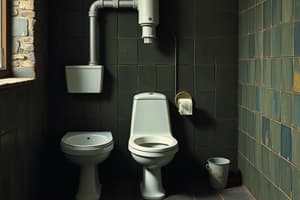Podcast
Questions and Answers
सेनेटरी पैड के डिजाइन में कौन सा तत्व मासिक रक्त को कपड़े पर लीक होने से रोकता है?
सेनेटरी पैड के डिजाइन में कौन सा तत्व मासिक रक्त को कपड़े पर लीक होने से रोकता है?
- एडहेसिव लेयर
- गौज पल्प
- पालीथीन (correct)
- हाइपोएलर्जेनिक और जलरोधी चिपचिपाहट
सेनेटरी पैड के अंदरुनी परत क्या काम करती है?
सेनेटरी पैड के अंदरुनी परत क्या काम करती है?
- मासिक तरलता को संकलित करना (correct)
- हवा को पैड में समाहित करना
- मासिक तरलता को कपड़े से दूसरी ओर ले जाना
- त्वचा को सुखा करना
सेनेटरी पैड के बाह्य परत की मुख्य उपयोगिता क्या है?
सेनेटरी पैड के बाह्य परत की मुख्य उपयोगिता क्या है?
- मासिक तरलता को सुकने से रोकना
- मासिक तरलता को पुन: प्राप्त करना
- हवा को पैड में समाहित करना (correct)
- कपड़े को अंदर से सुस्त करना
19वीं सदी में सेनेटरी पैड्स संसार में क्यों प्रस्तुत हुए?
19वीं सदी में सेनेटरी पैड्स संसार में क्यों प्रस्तुत हुए?
'सुपरएब्सॉर्बेंट पॉलिमर' में महिलाओं की मासिक तरलता को संकलित करने में हेल्प मिलती है, 'सुपरएब्सॉर्बेंट पॉलिमर' में मुख्य घटक क्या है?
'सुपरएब्सॉर्बेंट पॉलिमर' में महिलाओं की मासिक तरलता को संकलित करने में हेल्प मिलती है, 'सुपरएब्सॉर्बेंट पॉलिमर' में मुख्य घटक क्या है?
'सेनेटरी पैड' में 'हाइपोएलर्जेनिक' और 'पानी-संक्रमित' 'एडहेसिव लेयर' का उपयोग क््््््््््््््््््््हने से क््््््््््््��स�ह�ह�म�क�ಾ� �ह�ि�ह�ि� �ह��� �ह�ि� �ह��ि� �ह����� �ह��� �ह��� �ह��ि�?
'सेनेटरी पैड' में 'हाइपोएलर्जेनिक' और 'पानी-संक्रमित' 'एडहेसिव लेयर' का उपयोग क््््््््््््््््््््हने से क््््््््््््��स�ह�ह�म�क�ಾ� �ह�ि�ह�ि� �ह��� �ह�ि� �ह��ि� �ह����� �ह��� �ह��� �ह��ि�?
सैनेटरी पैड के पक्ष में निम्नलिखित में से कौन-सा सही है?
सैनेटरी पैड के पक्ष में निम्नलिखित में से कौन-सा सही है?
सैनेटरी पैड का सर्वांगिणीकरण करने के लिए किस प्रकार के पैड का उपयोग किया जाता है?
सैनेटरी पैड का सर्वांगिणीकरण करने के लिए किस प्रकार के पैड का उपयोग किया जाता है?
किस सैनेटरी पैड के मामले में संतुलित कीमत होती है?
किस सैनेटरी पैड के मामले में संतुलित कीमत होती है?
किस संकेत से पता चलता हो कि सही मात्रा में पाॅलिमर्स का उपयोग किया गया है?
किस संकेत से पता चलता हो कि सही मात्रा में पाॅलिमर्स का उपयोग किया गया है?
संतुलन को सुनिश्चित करने के लिए, किस प्रकार के सैनेटरी पैड सहायक होते हैं?
संतुलन को सुनिश्चित करने के लिए, किस प्रकार के सैनेटरी पैड सहायक होते हैं?
'ओर्गेनिक पैड' में सम्मिलित, प्रमुखत: क्या होता है?
'ओर्गेनिक पैड' में सम्मिलित, प्रमुखत: क्या होता है?
Flashcards are hidden until you start studying
Study Notes
Sanitary Pads: Understanding Menstrual Protection
Sanitary pads, also known as sanitary napkins or menstrual pads, are a common and widely used method for managing menstrual bleeding. While they may seem straightforward in concept, these pads have come a long way in their design and have been the subject of innovation and research to provide greater comfort, protection, and sustainability.
History of Sanitary Pads
Sanitary pads were first introduced in the 19th century as a more hygienic alternative to traditional rags and cloth menstrual protection. Initially, pads were made from cotton and gauze and were still often used with a belt or other adhesive to keep them in place.
Materials and Design
Modern sanitary pads are composed of several layers, each serving a specific purpose:
-
Adhesive layer: This layer typically uses a hypoallergenic and water-resistant adhesive to secure the pad to undergarments, ensuring it stays in place.
-
Absorbent core: The absorbent core is the most crucial part of the pad, as it collects menstrual fluid. This core is made from a combination of superabsorbent polymers and fluff pulp, which is soft and comfortable against the skin.
-
Barrier layer: This layer, usually made from polyethylene, prevents menstrual fluid from leaking onto clothing.
-
Breathable outer layer: The outer layer allows air to flow through the pad, helping to prevent odors and keeping the skin dry and comfortable.
-
Wings: Wings are extended flaps on either side of the pad, which help to secure the pad to undergarments.
Sanitary Pad Variants
Sanitary pads come in various sizes, absorbencies, and styles to meet the diverse needs of menstruators. Some common types include:
-
Regular pads: These pads are designed for moderate flow and are the most commonly used type.
-
Overnight pads: These pads have a higher absorbency and are designed for extended wear during heavy flow.
-
Thin pads: These pads are designed for light flow and provide minimal bulk.
-
Disposable pads: These pads are made from single-use materials and are discarded after use.
-
Reusable pads: These pads are made from washable materials, such as cotton or bamboo, and are designed for multiple uses.
-
Organic pads: These pads are made from organic materials, such as cotton, and are free from synthetic chemicals or fragrances.
Environmental Impact
Sanitary pads produce a significant amount of waste due to their single-use nature. As of 2019, an estimated 12 billion pads and tampons are thrown away annually in the U.S. alone. To reduce their impact on the environment, many companies are introducing eco-friendly sanitary pad options, such as biodegradable pads and pads made from more sustainable materials.
Potential Risks and Concerns
While sanitary pads are a safe and effective method for managing menstrual bleeding, some potential risks and concerns exist:
-
Allergic reactions: Some menstruators may experience allergic reactions to the materials used in sanitary pads, such as the adhesive or superabsorbent polymers.
-
Toxic Shock Syndrome (TSS): TSS is a rare but potentially life-threatening condition associated with the use of tampons and sanitary pads.
-
Environmental impact: The single-use nature of sanitary pads results in a significant amount of waste, which can contribute to pollution and harm to wildlife.
Despite these risks and concerns, sanitary pads remain a widely used and effective method for managing menstrual bleeding. With ongoing innovation and research, sanitary pad design continues to improve in terms of comfort, protection, and sustainability.
Studying That Suits You
Use AI to generate personalized quizzes and flashcards to suit your learning preferences.




